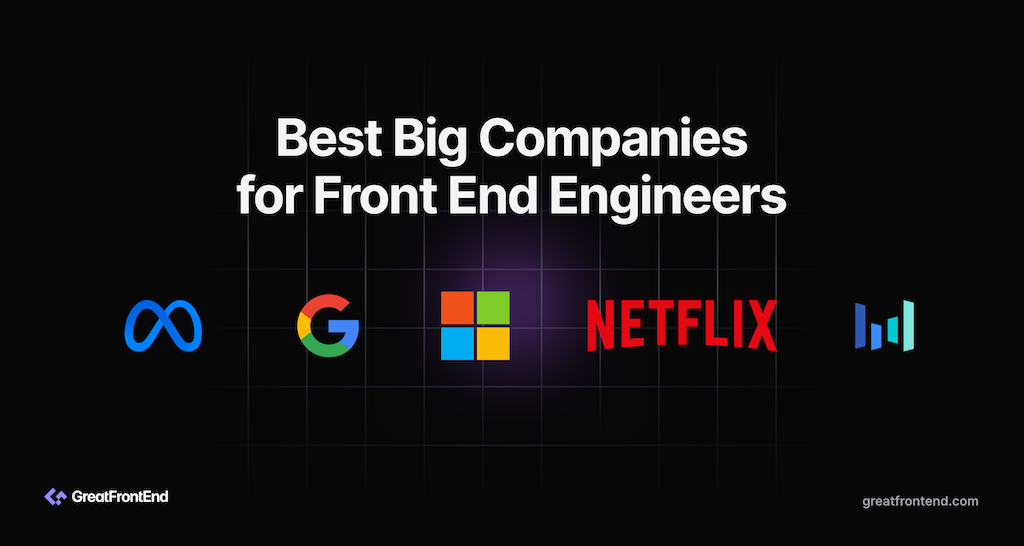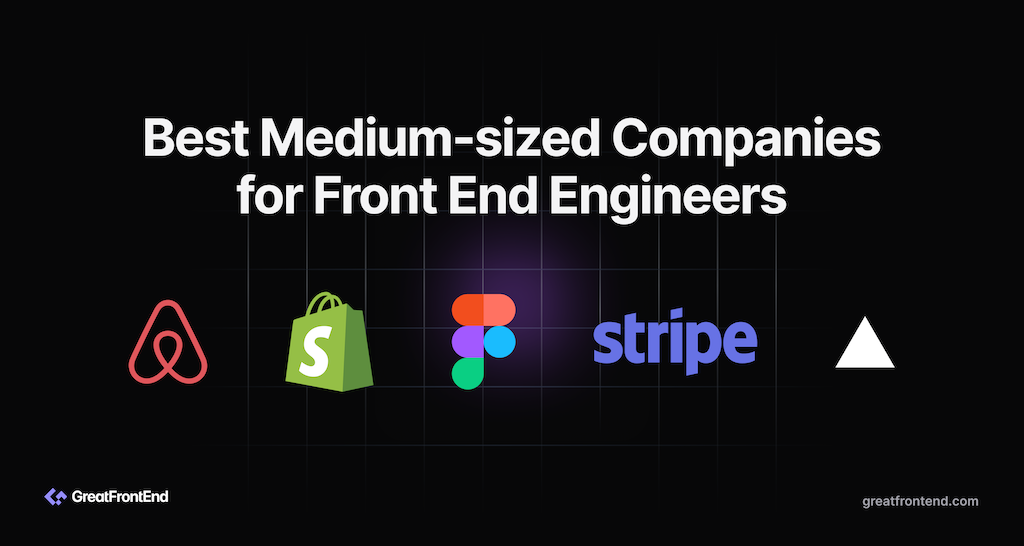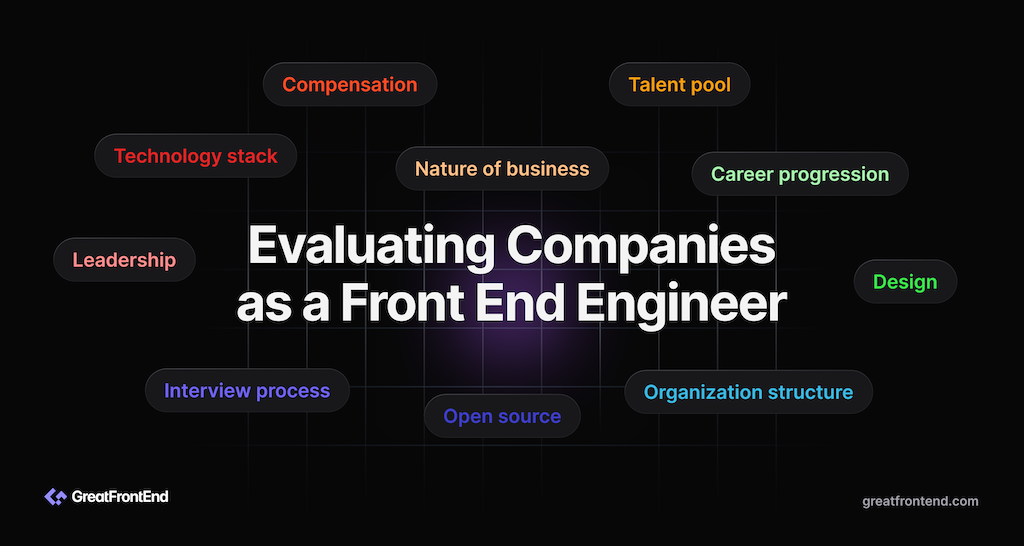Best Big Companies for a Fulfilling Front End Career
Discover the best big tech companies for a great career as a Front End Engineer.
When you're on the hunt for your next front end engineering role, it's not just about picking any company that'll have you. Companies differ in terms of domains, size, customers, etc. The importance of front end development to a company depends on the company's core offering. Naturally, a company that has a core product that is primarily used on the web will prioritize their front end engineering department, while for companies whose flagship products are mobile apps or hardware, front end development might take a backseat.
Whether it's working on cutting-edge technologies, being surrounded by inspiring colleagues, or contributing to projects you're passionate about, the right company can elevate your career from ordinary to extraordinary. Choosing the right company can make all the difference between leading a fulfilling career and hitting arbitrary career ceilings.
In this post, we have gathered the top tech companies for a fulfilling career as a Front End Engineer. Companies are selected based on the following criteria:
- Nature and variety of web products
- Complexity and quality of front end engineering
- Contributions to open source ecosystem
This post covers the list of the top big tech companies for front end engineers. For each company, we give a rating out of 5 on the following areas:
- Projects: Diversity, complexity and uniqueness of the products.
- Talent: Quality of talent.
- Design: Emphasis the company places on design.
- Compensation: How well compensated the employees are.
- Outlook: The company's outlook.
Meta (previously Facebook)
Let's get the obvious company out of the way. Meta (previously Facebook), is a major player in social networking, digital marketing, and has recently ventured into the realm of augmented and virtual reality. The complexity of their front end work is showcased in the Facebook and Instagram platforms, which are known for their visually rich interface and smooth user experience. Unbeknownst to most, the most complex (and possibly most important) web application at Meta is their Ads Manager application as it has to display and manage thousands of rows of ad campaigns and also allow advertisers to create ad creatives in various formats for different platforms. The ads manager and business suite surfaces are worked on by thousands of engineers across the company.
When the Facebook.com redesign was released in 2020, it was considered the gold standard for web applications as it popularized the concepts of SSR, lazy loading, prefetching on navigation, and data-driven dependencies. Today, most new applications at Meta are built using this JavaScript-centric tech stack.
If I were to name a company that has the most impact on the open source front end ecosystem, it has to be Meta. Meta revolutionized how UI was built with the invention of React and React Native, introduced new data fetching approaches with GraphQL, built Jest, a feature-rich test runner that displaced then-frontrunner Mocha, made building documentation websites easy with Docusaurus, and Yarn, a package manager that was a huge improvement over npm at the time of its release. Meta has open sourced technology in almost every aspect of front end development most of which achieved widespread adoption at one point in time, which speaks volumes about the standard of Meta's front end engineers and importance of front end development to the company. Because much of Meta's front end technologies are open source and widely-adopted, new developers who had prior experience with these technologies will have an easier time when onboarding.
Meta is continuing to lead innovation in the front end space with the development of React Server Components, Server actions, React forget, and cross-platform React components so that users can share components between web, mobile, and VR environments.
Notable figures in front end development from Meta includes Jordan Walke, the creator of React and Reason; Joe Savona, who is currently working on the React Forget compiler; Dan Abramov, Sebastian Markbåge, Lauren Tan, Andrew Clark, Dominic Gannaway, Brian Vaughn, Sophie Alpert, Rick Hanlon, who have worked / are still working on React, Christopher Chedeau of Prettier and CSS-in-JS fame; and Christoph Nakazawa, who worked on React Native, Jest, and Metro.
Meta's front end interview process is one that heavily favors Front End Engineers as it is focused on practical front end domain knowledge without excessive emphasis on algorithmic knowledge.
While Meta is a great place for Front End Engineers, it can be stressful working there. The company is known for its fast-paced and results-driven work environment that rewards high performers, which can contribute to tight deadlines and stress. Employees may also face public scrutiny due to the company's high-profile nature and history with privacy concerns and misinformation. The demanding nature of the work and high expectations, coupled with potential challenges to work-life balance, are factors individuals should consider. On the engineering side of things, Meta is stuck using Flow for writing type-safe JavaScript, which is almost no longer used outside of Meta. However, there are some similarities with TypeScript, so the learning curve should not be too huge.
Rating: Projects (4/5), Talent (5/5), Design (4/5), Compensation (4.5/5), Outlook (3/5)
Google, a global technology leader, is best known for its search engine. However, the company's reach extends far into areas such as video streaming, cloud computing, AI, consumer hardware, and software solutions. Some of their products that showcase intricate front end development include YouTube, the world's top video streaming website; Google Maps, with its interactive maps and street views; Gmail, a widely-used email service featuring a sophisticated interface; and Google Docs, an online word processor offering real-time collaboration.
Google's commitment to the front end open source ecosystem is evident in projects like:
- Angular: One of the big three web application frameworks, popular among enterprise applications. The newly-released Angular 17 renews developers' confidence in the framework and that Google is still investing in it.
- Chromium: The browser that powers Google Chrome. Did you know that other major browsers like Microsoft Edge, Opera, and Arc are also powered by Chromium?
- Flutter: Google's approach of building cross-platform, natively compiled apps for mobile, web, and desktop from a single codebase. Dart is the primary language for developing Flutter apps.
- Dart: A programming language by Google that can be transpiled to JavaScript but can also be used to build server, desktop, and mobile applications. Within Google, Dart is primarily used for building ads products.
Google is home to many prominent figures in the front end community because they regularly create great guides and content for web development like web.dev and YouTube channels like Chrome for Developers. Paul Irish is known for his work on Chrome DevTools and other web development resources; Addy Osmani, Software Engineer on Google Chrome and author of numerous technical books; Minko Gechev, tech lead and manager for Angular.
Google's front end interview process has a good balance of algorithmic knowledge and domain knowledge. There are pure algorithmic rounds and front end coding questions will also require a good grasp of software design and good data structure choice.
Working at Google, while offering numerous benefits, comes with potential downsides. The large organizational structure of the company may pose challenges in communication and decision-making, and frequent reorganizations can create uncertainty for employees. Projects are often canceled and I have lost count of the number of instant messaging applications that were built, killed, and rebuilt. Despite these downsides, Google's cutting-edge projects, great salary, career growth opportunities, and focus on employee well-being continue to attract top talent.
Rating: Projects (4.5/5), Talent (4.5/5), Design (4/5), Compensation (4/5), Outlook (4/5)
Microsoft
Microsoft, a household name in software, offers a range of products from operating systems to cloud services and business solutions. Besides Bing and Edge, the Microsoft 365 suite brings traditional workplace offerings like Word, Excel, and PowerPoint to the web which are complex web applications that require a high level of front end to create.
For a long time, Microsoft was focused on desktop applications but in recent years, Microsoft has increased investment in developing the web ecosystem and have established themselves as one of the most important companies to the future of front end development with the following projects:
- TypeScript: A popular type-safe superset of JavaScript. TypeScript mastery is considered a core skill these days.
- Visual Studio Code: A free, highly customizable cross-platform code editor. It is one of the most popular IDE for web development and comes with out-of-the-box TypeScript integration.
- Playwright: A framework for Web Testing and Automation. It allows testing Chromium, Firefox and WebKit with a single API.
- npm: The de facto package manager for the JavaScript ecosystem is currently owned by GitHub, which is owned by Microsoft.
Moreover, Microsoft is heavily investing in AI. They're the largest investors in OpenAI and OpenAI utilizes Azure as its primary cloud provider to train and run its large-scale AI models. Microsoft has been integrating OpenAI's technologies into its products, like GitHub Copilot, Microsoft 365 products and Bing search engine, among others. The partnership with OpenAI gives it a competitive edge in the AI race, especially against other tech giants like Google and Amazon. By closely working with and funding one of the most advanced AI research labs, Microsoft positions itself at the forefront of AI innovation.
In a company as large as Microsoft, bureaucratic processes are often in place. This can mean slower decision making, more layers of management, and a need to navigate through a complex corporate structure to get things done. For some, this can feel restrictive and stifle creativity.
Rating: Projects (4/5), Talent (4/5), Design (3.5/5), Compensation (3.5/5), Outlook (4/5)
ByteDance/TikTok
The only Chinese technology company on the list, ByteDance is most famous for its social media app TikTok, which is a highly addictive platform that prioritizes mobile-first short-form videos. While TikTok content is primarily consumed on mobile platforms, ByteDance has a large suite of enterprise offerings for the web, like Lark and BytePlus.
ByteDance is actually pretty active in the open source community, though their projects are less known compared to those from Western big tech companies. One of ByteDance's most famous open source projects is rspack, a Rust port of webpack. Other notable projects include IconPark, a high quality, highly customizable icon set and Xigua player, a modern video player for the web.
ByteDance is home to many talented individuals like Zack Jackson (Creator of module federation) and Dexter Yang (Author of Spellbook of Modern Webdev). Anthony Fu, one of the most prolific open source leaders in recent years, used to work at ByteDance.
In terms of the hiring process, ByteDance's front end interview process is one of the toughest to crack due to their wide pool of questions that tests the candidates' breadth and depth in the domain. Candidates can expect to answer tough trivia questions about their favorite JavaScript framework and the front end domain. All of algorithms, JavaScript utilities, UI coding, and system design questions can also be asked.
ByteDance is very similar to Meta in many ways and I often tell people they're the Meta of China – their focus on social products, performance-driven culture that disproportionately rewards high performers, mindset which encourages moving fast and taking ownership, open sourcing innovative technologies, etc.
However, being a Chinese company, might have a corporate culture that differs significantly from Western norms. Engineers from different cultural backgrounds might find it challenging to adapt to these differences in work style, communication, and management practices. TikTok is constantly under scrutiny in the United States due to national security concerns related to its Chinese ownership and there's no knowing if or when the app will be banned in the US, which will hurt the business greatly.
Rating: Projects (4/5), Talent (4/5), Design (4/5), Compensation (4/5), Outlook (4/5)
Netflix
Netflix, the leading entertainment streaming service, is renowned for its personalized user interfaces and seamless streaming experience across devices. Netflix is one of the best places for front end engineers not because of Netflix.com; it is their suite of complex web-based studio technologies that makes working there exciting.
Netflix's primary contribution to the open source community is Falcor, a JavaScript library for efficient data fetching. Notable front end developers from Netflix include Jafar Husain, known for his work on reactive programming and JavaScript frameworks. Jafar has also worked at Meta on GraphQL.
Netflix's company culture, often compared to a professional sports team, is centered around performance, collaboration, and a high degree of freedom and responsibility. This culture is detailed in their "Netflix Culture: Seeking Excellence" document and is widely recognized in the business world for its unique approach. Netflix is known for paying top of the market salaries for Software Engineers and mostly in base salary. Employees at Netflix have the flexibility to decide how much of their compensation is in cash or stock options. On the other hand, the dream team culture can lead to workplace competitiveness and increased stress as employees may feel they must constantly prove their worth to remain with the company.
Rating: Projects (3.5/5), Talent (4/5), Design (4/5), Compensation (5/5), Outlook (4/5)
Related articles
 Discover the best medium-sized tech companies for a great career as a Front End Engineer.
Discover the best medium-sized tech companies for a great career as a Front End Engineer.